A classic American side dish, let me show you how to make Boston baked beans from scratch. Sweet, savory, and meaty, with bacon and molasses. It's worth the work. Soak dried beans tonight and get ready for fantastic Boston baked beans from scratch tomorrow.
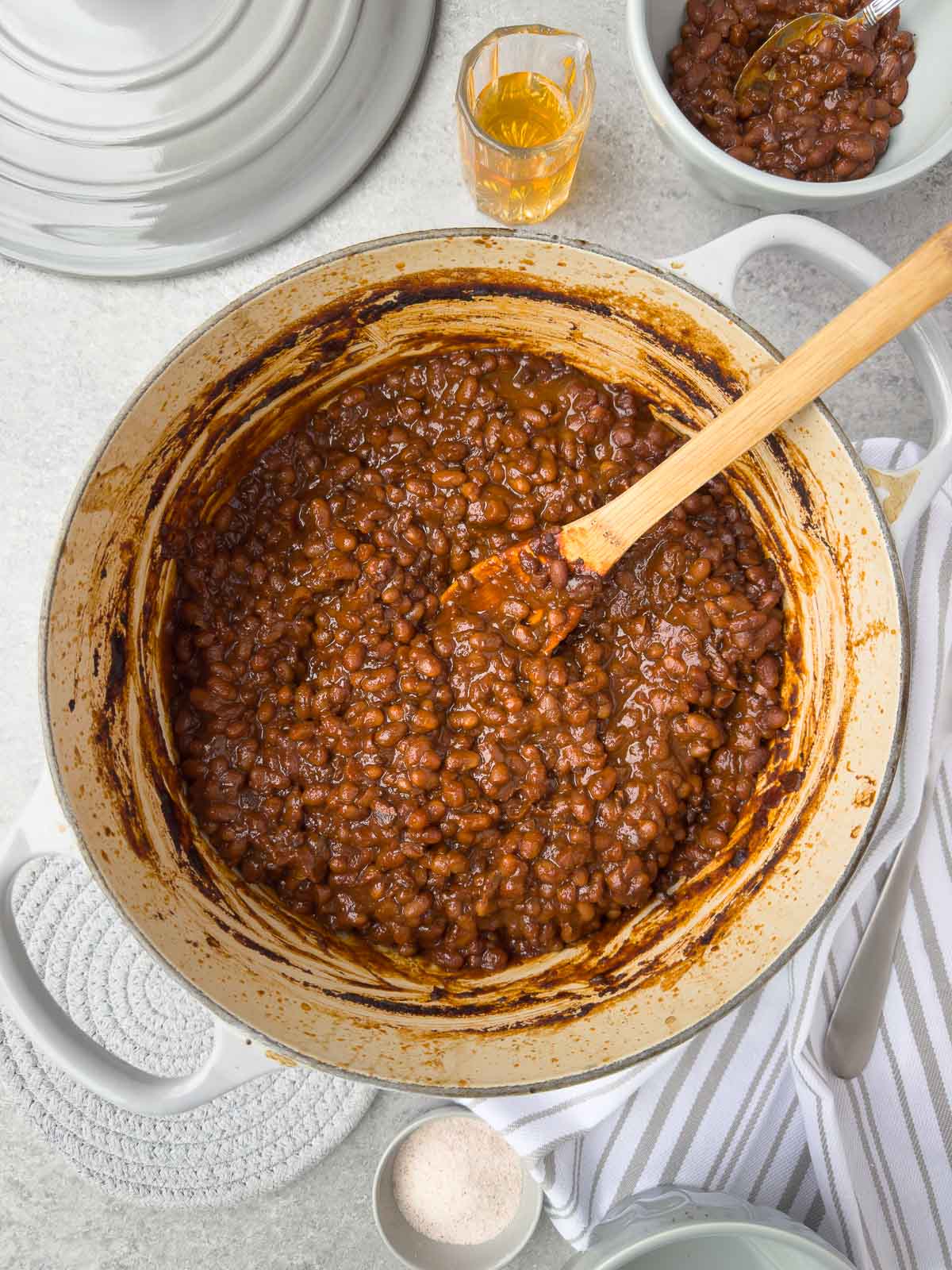
Making baked beans from scratch takes longer than starting with canned beans, but the work is spread out: soaking, simmering and finally baking. Much of the time is hands off. I think the results are worth it. Nothing beats homemade baked beans from scratch.
Jump to:
Why You'll Like This Recipe
- A classic American summer side dish, but good year round.
- Can be made vegan or vegetarian without bacon.
- I walk you through it step-by-step.
For a quick and easy three-bean salad, try this recipe or this summer white bean salad. Both use pantry staple canned beans and are made in minutes.
Recipe Ingredients

I've taken a few liberties with the traditional recipe, like using Dijon mustard versus dry mustard, and adding smoked paprika (it's optional), but what amazing depth of flavor these baked beans have.
- Dried beans: use dried beans, not canned. Navy beans are the classic for baked beans, but see notes below for options
- Oil: olive oil is my go-to but avocado oil works fine.
- Bacon: Use thick sliced bacon (versus traditional salt pork or ham bone).
- Onion: yellow or brown onions add sweetness, moisture, and flavor.
- Garlic: adds that savory pungency to soups, stews, and definitely baked beans.
- Molasses: a must for Boston baked beans! Provides sweetening and a rich, deep color for classic baked beans. I use what is labeled unsulphured molasses but if you read the ingredient list it says blackstrap.
- Sugar: light brown sugar or use golden monk fruit blend to reduce sugar.
- Ketchup: I use unsweetened ketchup. Here is my go-to clean ketchup brand.
- Mustard: dry ground mustard is traditional but I use Dijon.
- Vinegar: use apple cider vinegar for balancing the sweetness.
- Paprika: not a traditional ingredient but I like adding smoked paprika (optional).
- Bay leaf: adds a subtle depth of flavor for pot beans, soups, stews, dried or fresh.
Additionally: for the simmering phase of the baked beans you need another onion (actually half of one), a celery rib, carrot, bay leaf, thyme sprigs, and garlic cloves for flavoring. This is optional but adds flavor.
Please see the recipe card for all measurements including salt and black pepper.
Substitutions and Variations
- To substitute dry mustard, use 1 teaspoon instead of 1 tablespoon of Dijon.
- Bean options: substitute dried Great Northern beans or cranberry beans for navy beans. Another option, try these heirloom bean varieties: Marcella bean, Alubia Blanca, or Yellow Eye bean.
- Omit the bacon for vegetarian or vegan Boston baked beans, and use olive oil to saute the onion instead of bacon fat.
- Add ginger; it's a flavorful addition to baked beans. I use the jarred ginger puree, or use finely grated or zested fresh ginger root. Saute it with the onions.
- For more of an entree, add browned ground beef or turkey. Chopped cooked chicken sausage is good too.
- Add a splash of good Balsamic vinegar.
Chef's Tip: Why soak beans? Soaking hydrates the beans, softens the thick outer skins, helps beans cook more evenly, speeds up the cooking process. Adding kosher salt (which is brining) while soaking improves the flavor further and seasons the beans more evenly. Most beans are better with soaking and brining. Soaking and brining also minimizes burst beans. Here's a good reference article.
Recipe Instructions
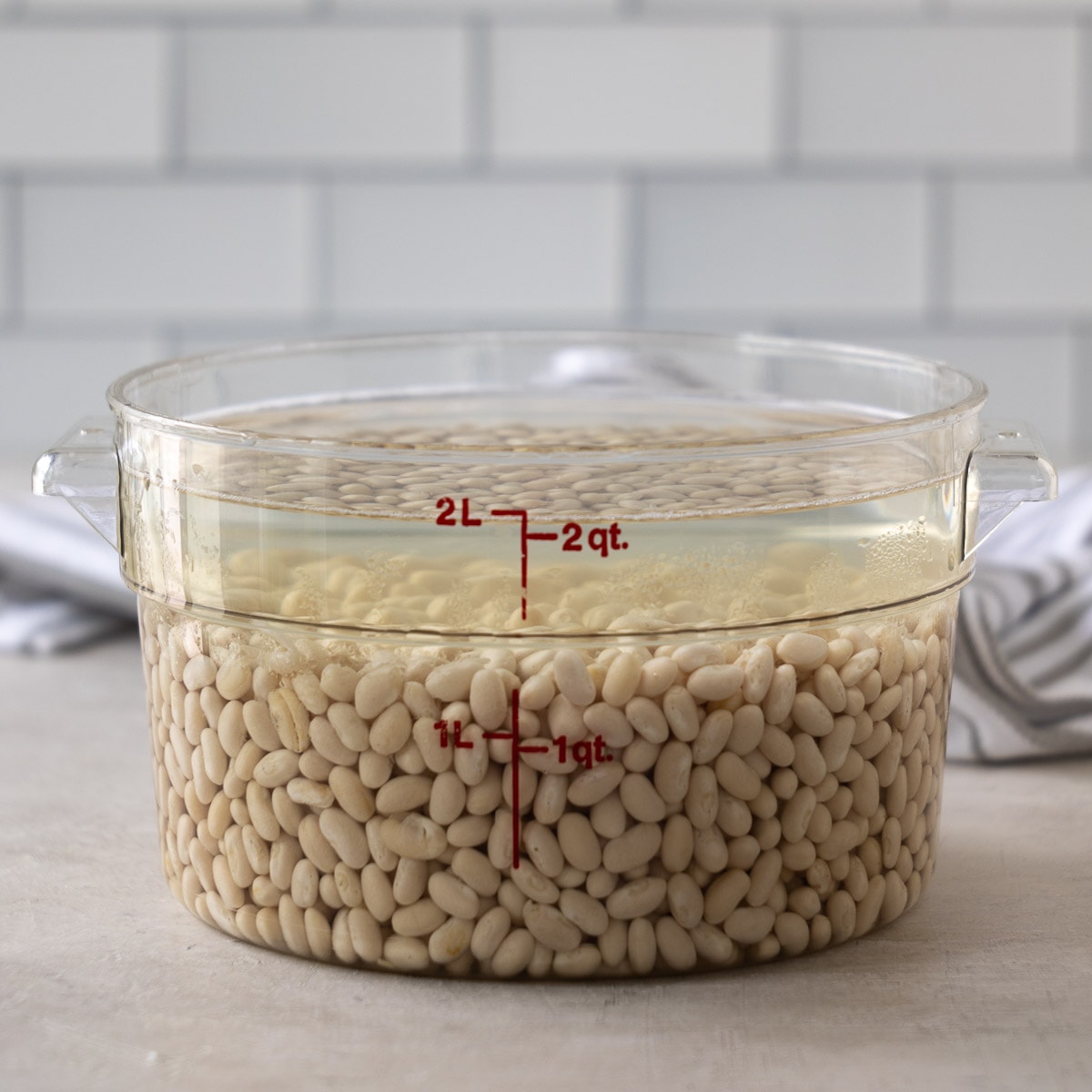
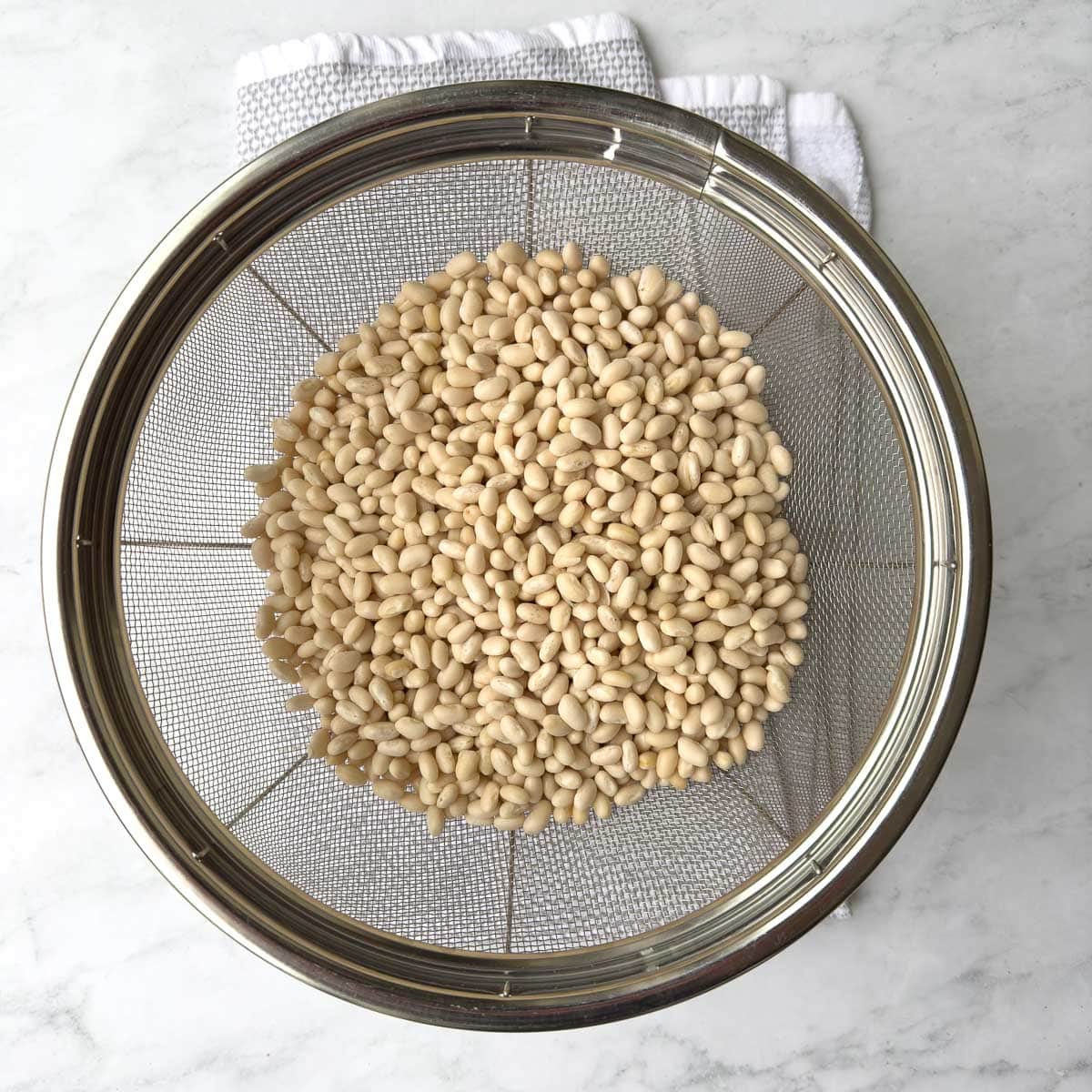
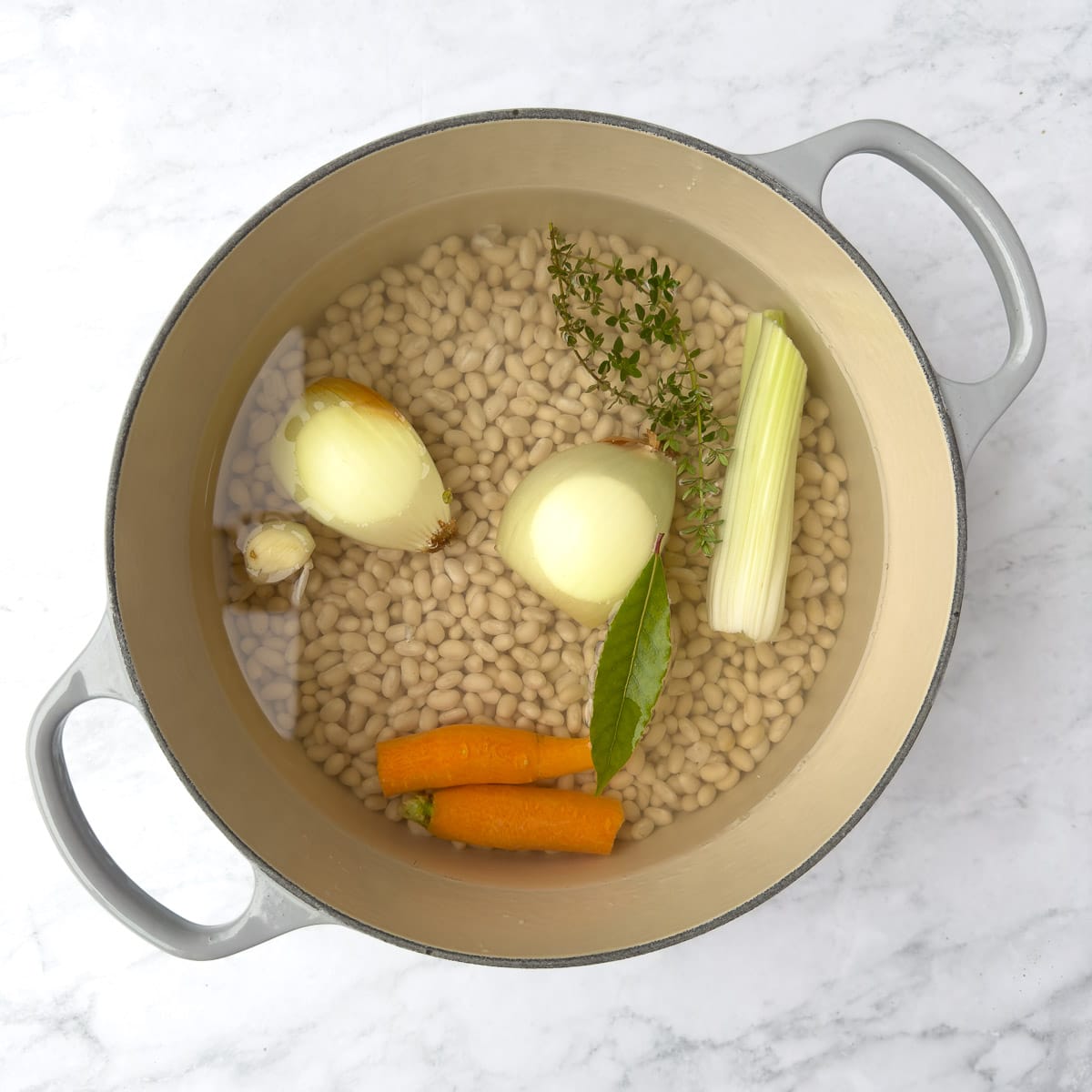
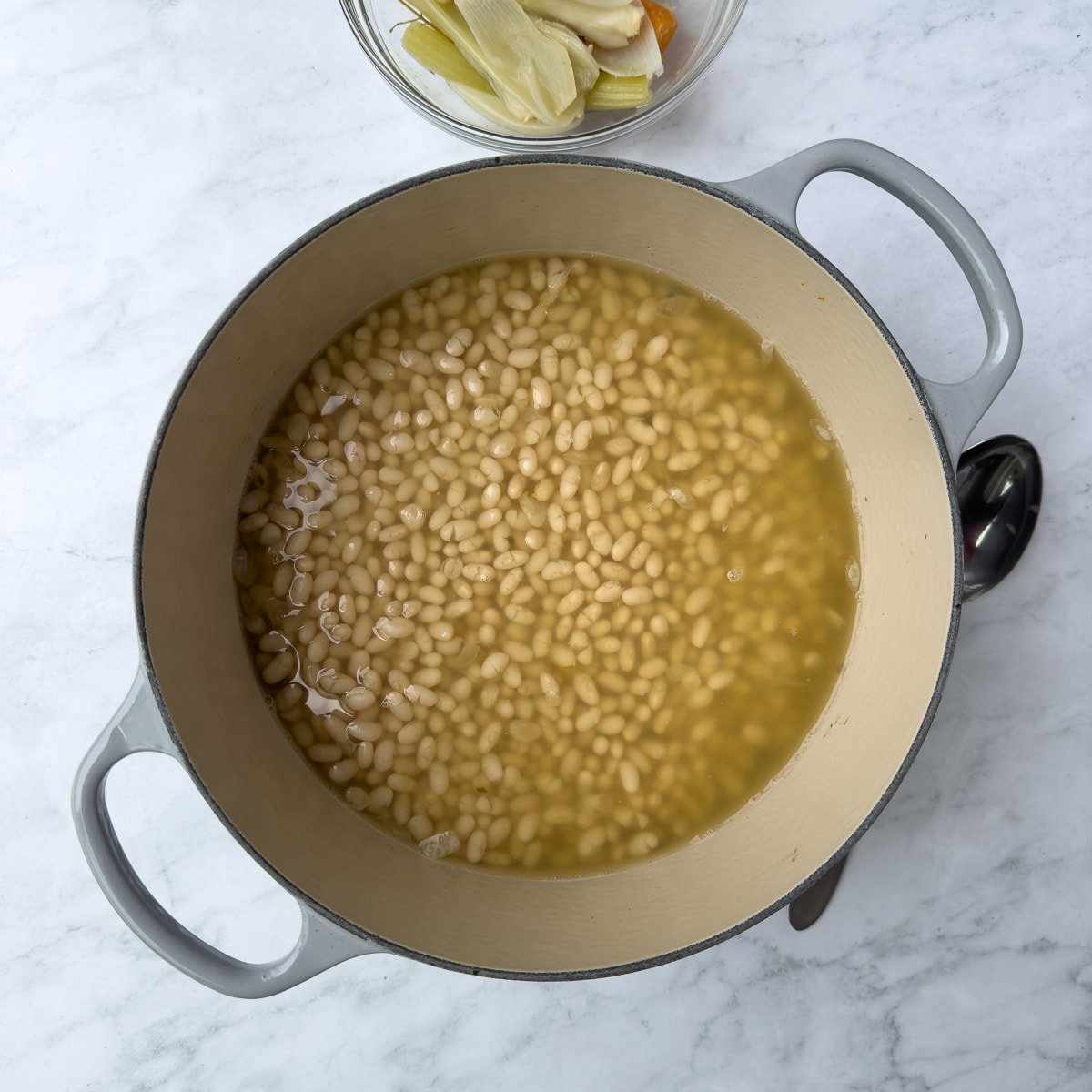
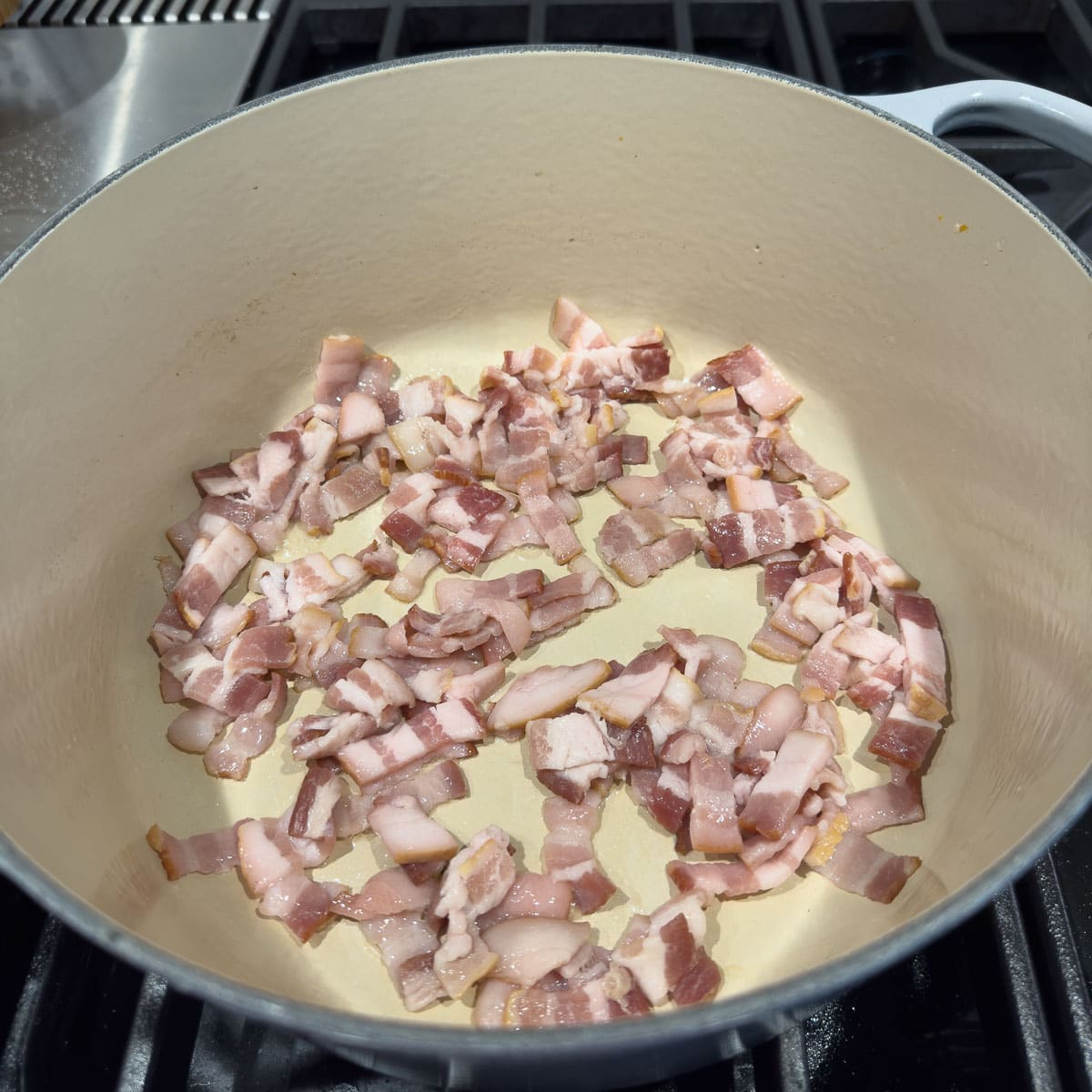
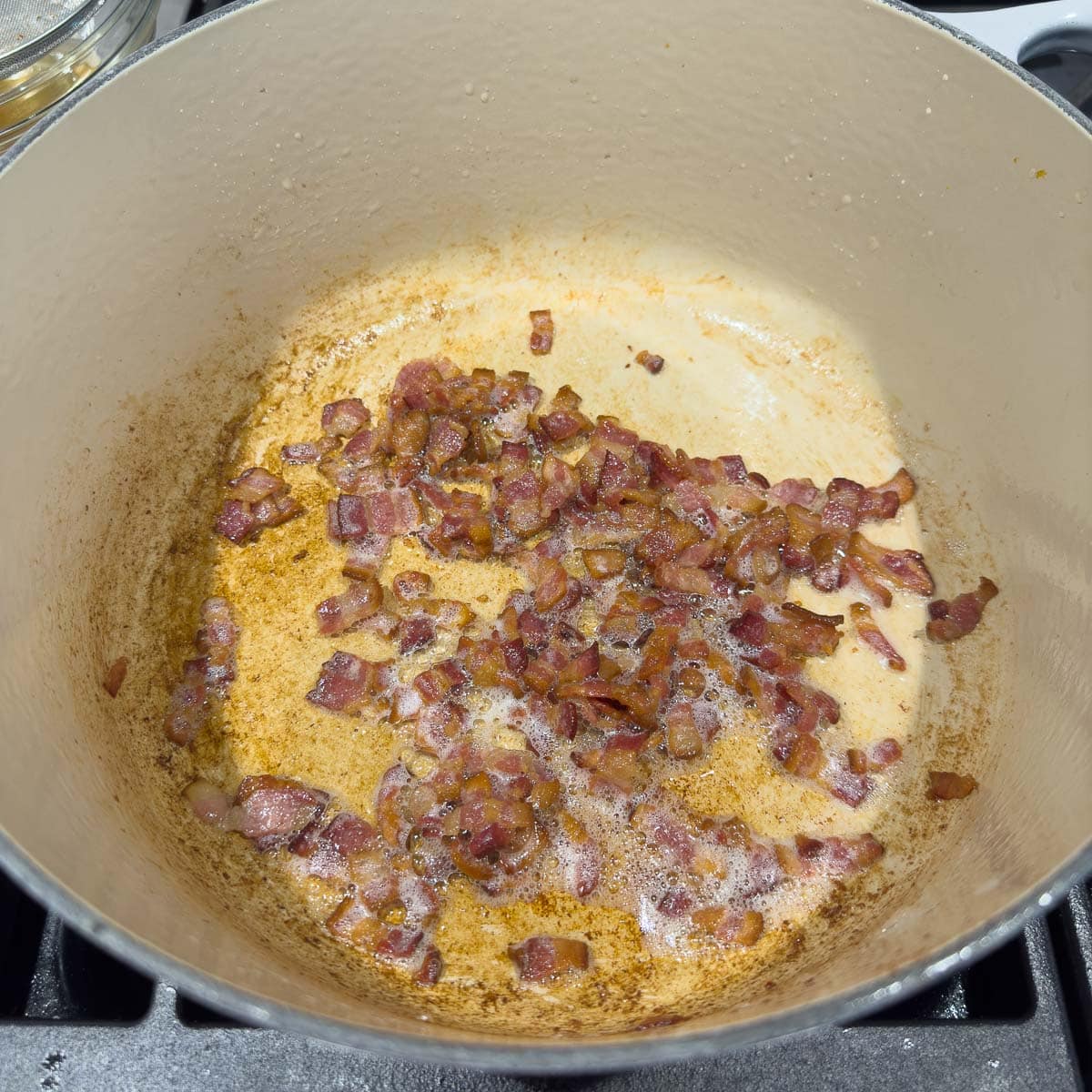
Note: Omit bacon step for vegans or vegetarians and use olive oil to cook onion and garlic.
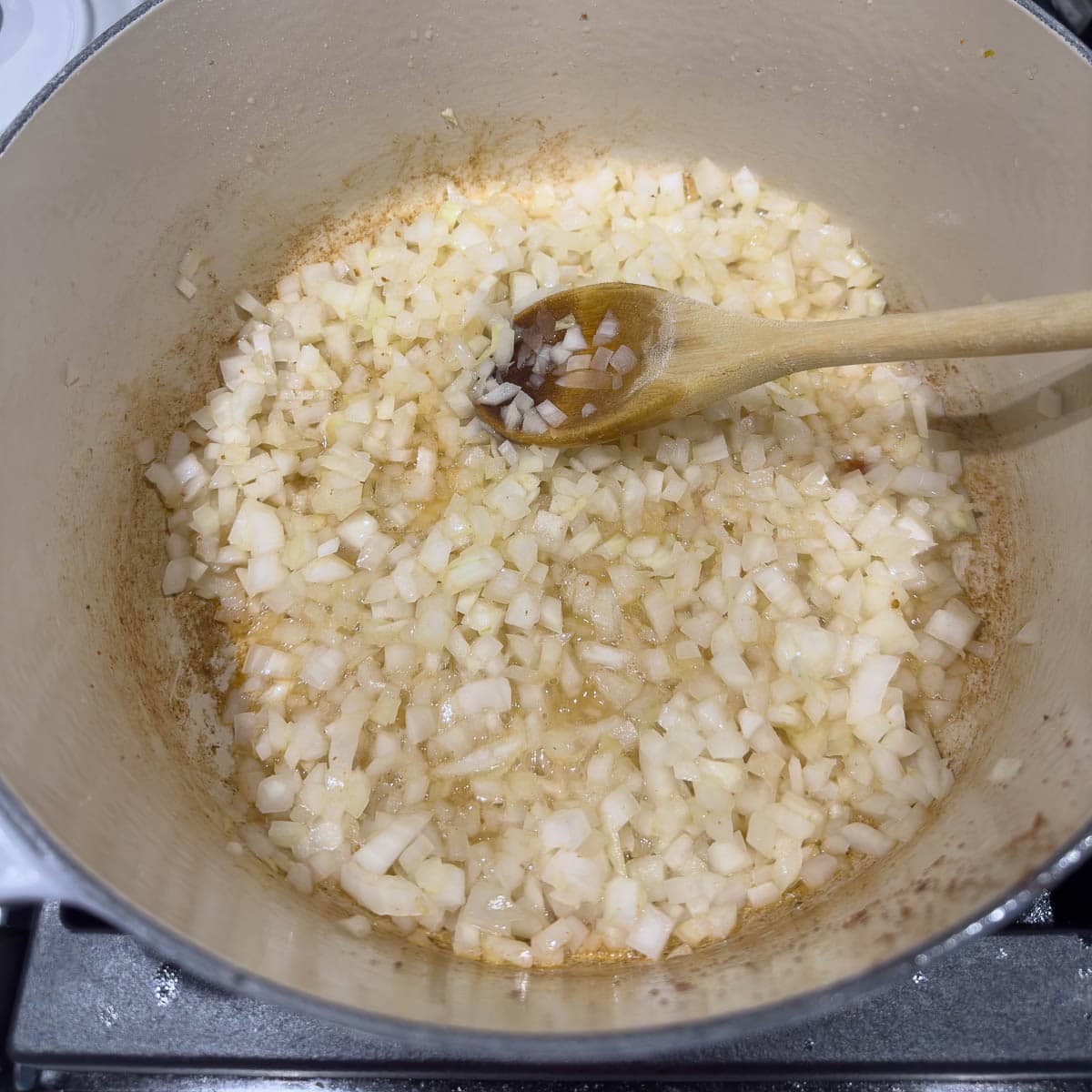
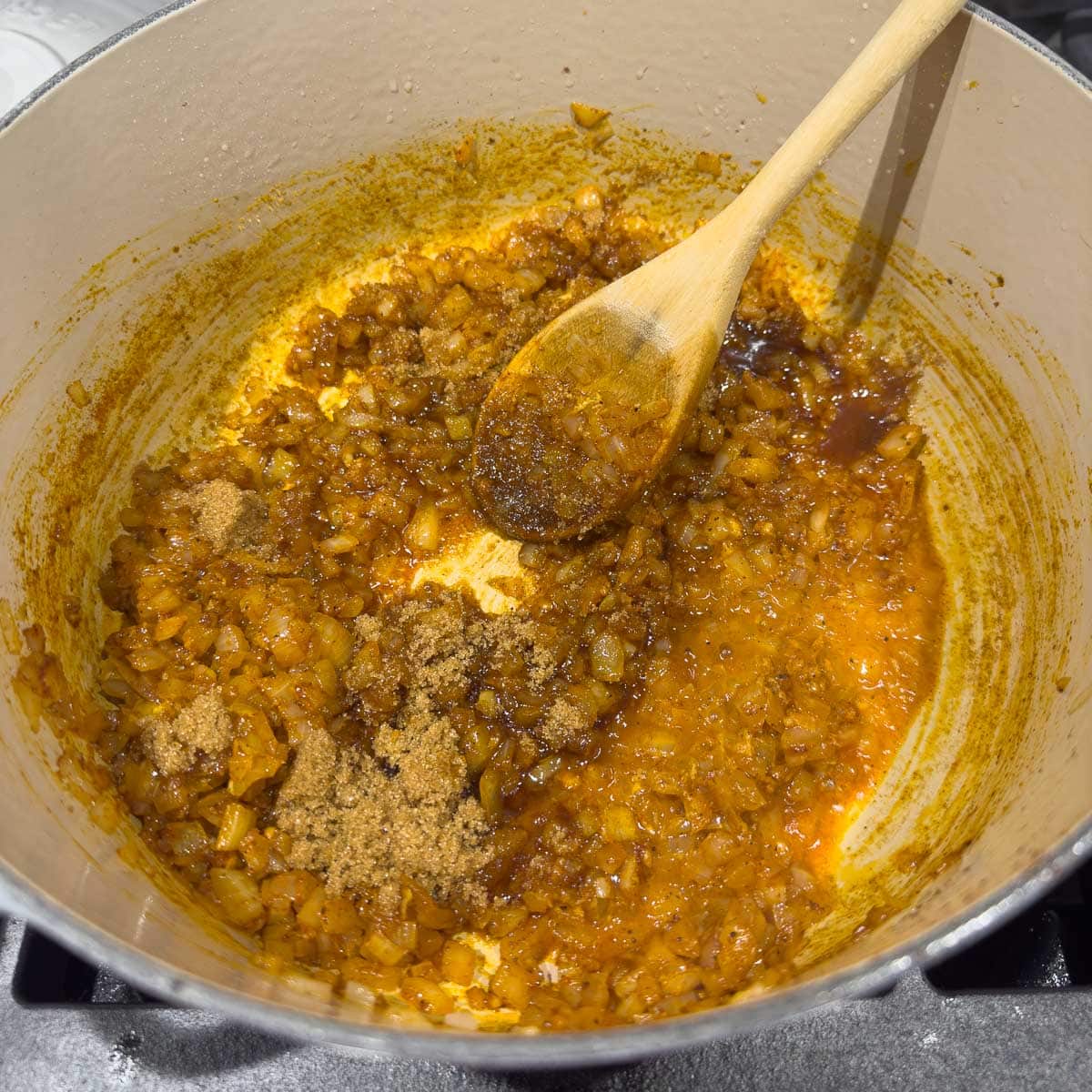
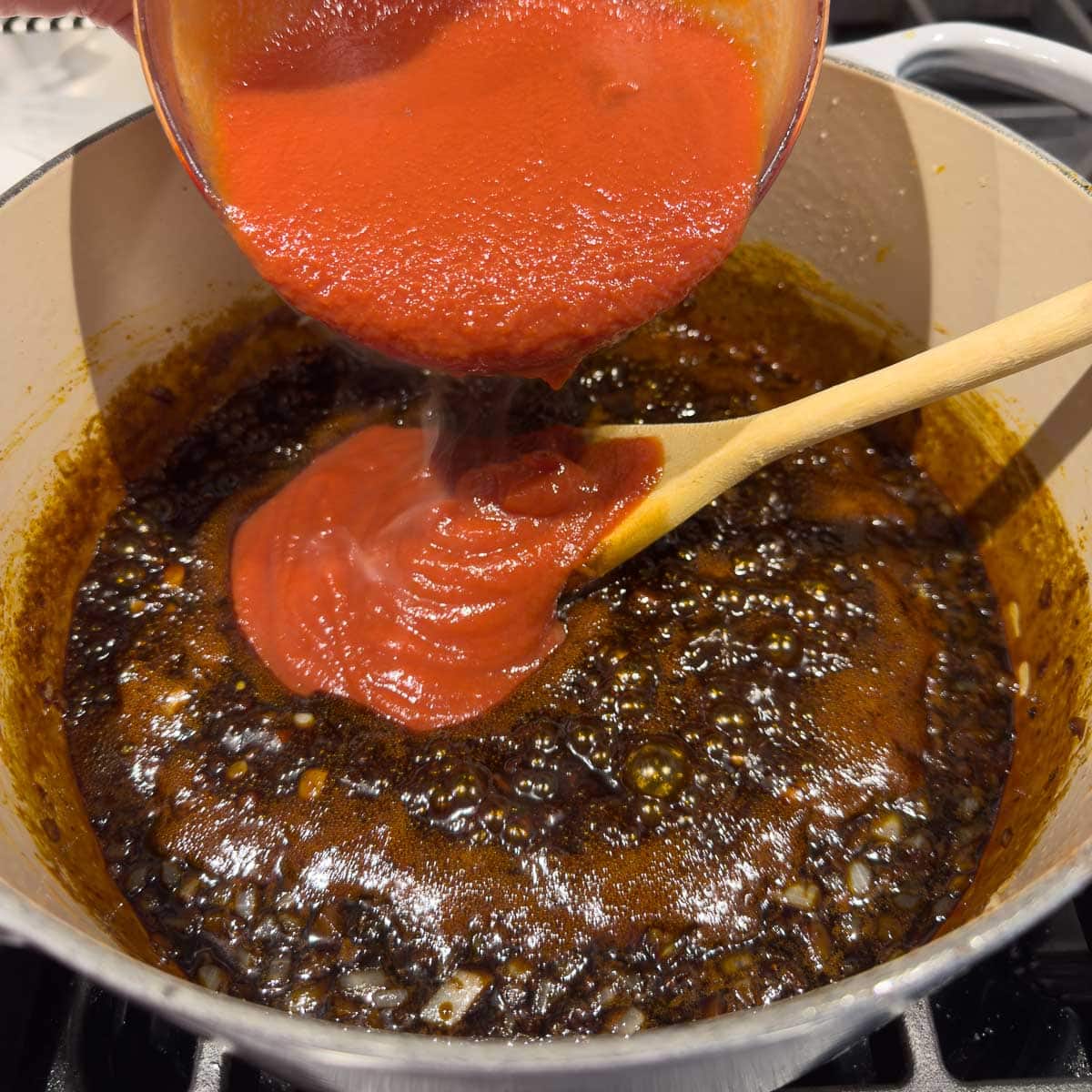
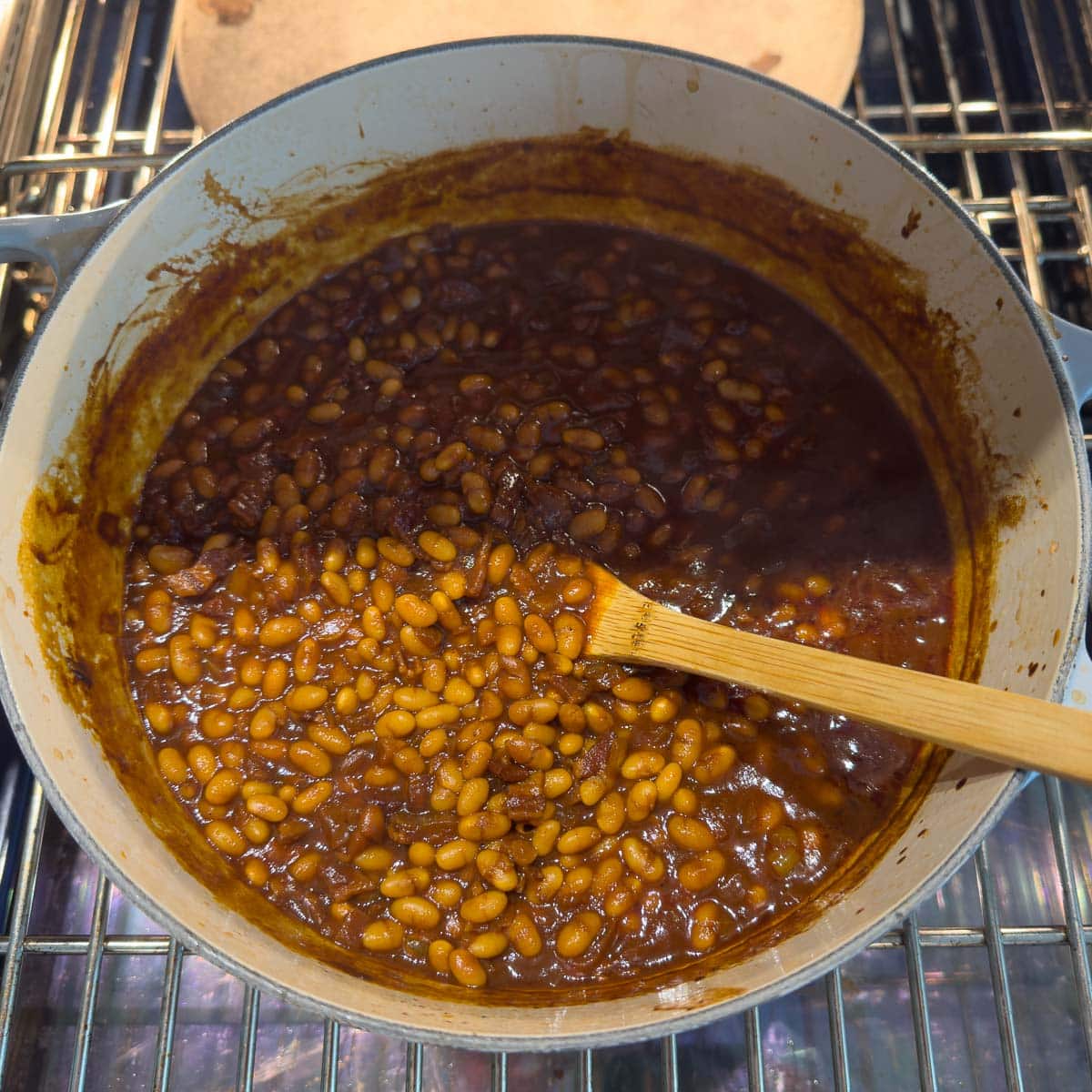
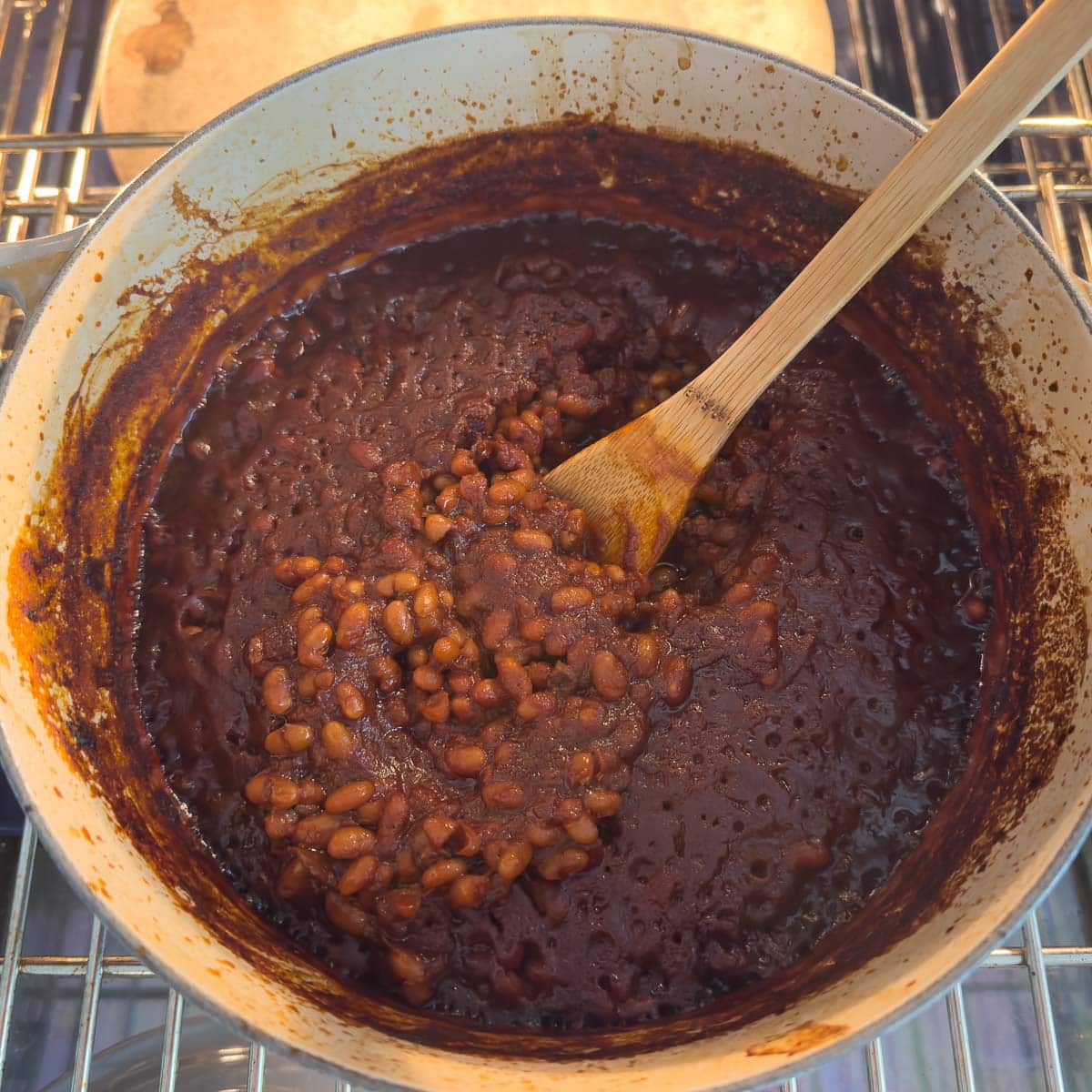

Chef's Tip: Discard the soaking water or not? There is conflicting advice on which is best. Some reports advise saving and cooking with the soaking water as it contains nutrients and starches. Other reports advise discarding the soaking water and cooking with fresh water to improve digestibility. I recommend discarding soaking water and starting with fresh. It's a must if you add salt to your soaking water (brining).
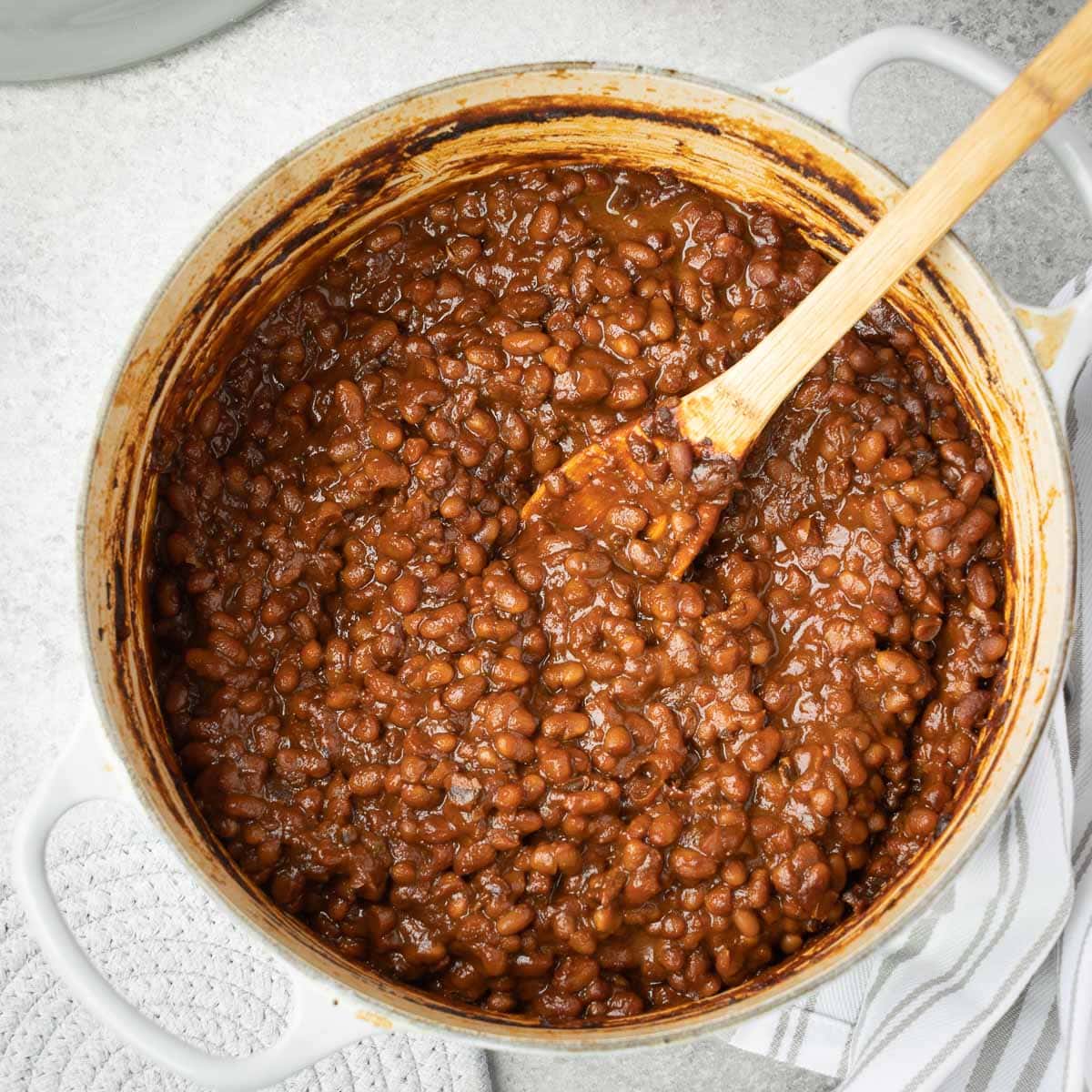
How to Quick Soak Dried Beans
If you forgot to soak your dried beans overnight, use the quick soak method to get them ready for cooking. Rinse the beans well with cold water in a colander discarding any broken beans.
Place beans in a large heavy pot such as a Dutch Oven and cover with fresh water by several inches. Add a tablespoon of salt. Bring beans to a boil and cook for 2 minutes. Turn off heat, cover the beans and let stand on the stove for 1 hour. Drain and proceed with the recipe.
Chef's Note: shortcut soaking and simmering steps with a pressure cooker or Instant Pot. Start with un-soaked dried beans and using this time table, pressure cook the beans until tender, then continue with cooking the bacon and baking.
Serving Suggestions
What do you eat with baked beans? They are the perfect side dish for burgers, hot dogs, or my favorite, baby back ribs with homemade sauce. Here are a few side dishes for your summer barbecue menu:
- Mediterranean potato salad.
- Fresh homemade coleslaw (light on the mayo).
- Summer green bean salad with corn and tomatoes.
- A big green salad.
- Corn on the cob.
If Boston baked beans are a bit sweet for you, add a little more apple cider vinegar. If they need a bit more sweetness, add a little New England maple syrup. It's a nice compliment to the molasses and brown sugar in the recipe.
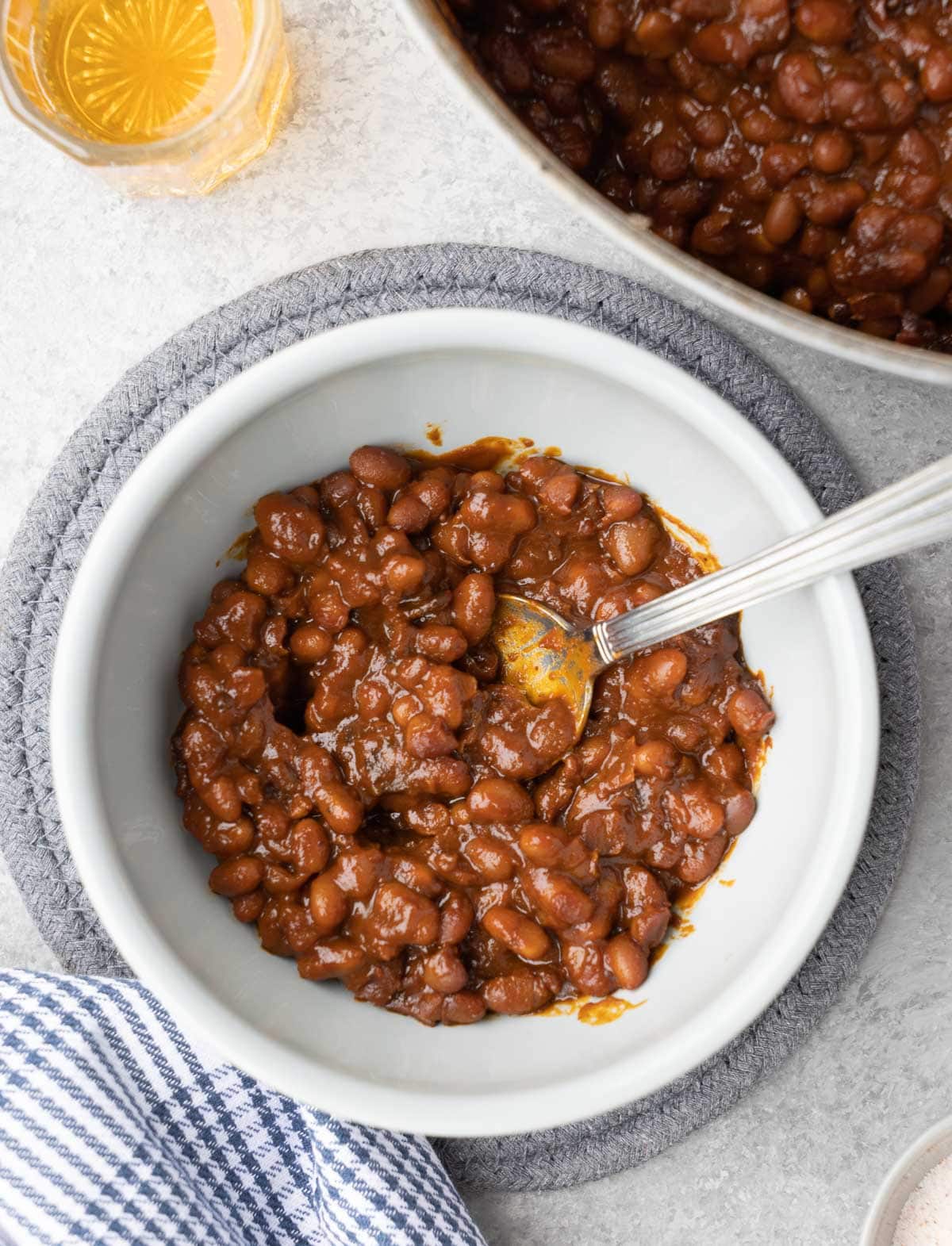
Re-heating Tips
If making the beans a day or two ahead, cool the beans (to 70°F minimum) and refrigerate covered. They firm up a lot when they get cold, so they will need a little water to get creamier. Leftover baked beans re-heat well.
Oven heating for a whole pot: if needed, stir in a a little saved bean broth or water if you want them juicier and heat in a 325°F oven for approximately 1 hour or until the beans reach a minimum 165°F measured with a digital thermometer. This works well for a whole pot.
For stovetop heating: stir in a little saved bean broth or water, cover and use low heat, stirring occasionally until hot. Take care that the bottom does not scorch.
For microwave heating: portions may also be microwaved, covered, on 70% power.
Recipe FAQs
What makes Boston baked beans different is the use of molasses, according to this historic website. Molasses is a thick, dark brown syrup, a result of the sugar refining process. It adds a rich, sweet depth of flavor and gorgeous color to Boston baked beans. Molasses is why brown sugar is brown in color.
The traditional dried bean for Boston baked beans is the navy bean, but other small white beans work as well. Great Northern beans are the perfect swap, but pinto beans, and cranberry beans work beautifully.
Your beans might be hard no matter how long you've cooked them due to several factors. It could be the beans are old and dried out or were improperly stored. Old beans can mean hard beans.
If you're concerned about the beans being old, use this bean softening trick; add ¼ teaspoon of baking soda to the soaking water. Don't use too much because you don't want mushy beans.
It could be the hard or chlorinated water. Use filtered water versus tap water as minerals like calcium can prevent beans from softening. Hard water can make for hard beans. Chlorinated water can also be a culprit.
More Terrific Summer Recipes
Need more ideas for summer menus? Here are a few for the grill and side dishes too. For more inspiration see the side dishes category. For a mulit-purpose grilling and dipping sauce, try this homemade hoisin sauce (gluten-free too).
⭐️Did you Make This Recipe?
If you make this recipe, please add your comment. I appreciate your feedback and enjoy hearing from you. If you loved it, please give it a 5-star rating! They really help other readers.
📖 Recipe
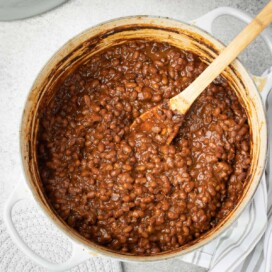
Boston Baked Beans from Scratch
Equipment
- Large heavy pot or large Dutch oven 5 ½ quarts with lid
Ingredients
Basic bean soaking
- 1 pound dried small white beans such as navy beans see notes below on bean options
- 1 ½-2 quarts filtered water enough to cover the beans by 4 inches for soaking
- 1-2 tablespoons kosher salt for brining 1 tablespoon per quart of water
Bean pre-cooking (aromatics)
- ½ onion yellow or brown
- 1 carrot peeled and cut in half crosswise
- 1 rib celery cut in half crosswise
- 2 garlic cloves peeled and smashed
- 1 bay leaf
- 2 fresh thyme sprigs sub sage leaves or rosemary
Baked beans
- 6 ounces thick cut bacon chopped crosswise into strips
- 1 ½ cups chopped onion, yellow or brown 1 large onion
- 2-3 garlic cloves finely chopped
- ⅓ cup light brown sugar or golden monk fruit blend
- 1 tablespoon apple cider vinegar
- 2 teaspoons regular or smoked paprika optional
- 1 ½ teaspoons sea salt
- ½ teaspoon ground black pepper
- ½ cup unsulphured blackstrap molasses
- 1 ½ cups unsweetened ketchup
- 1 tablespoon Dijon mustard sub 1 teaspoon dry mustard
- 1 bay leaf
Instructions
Soak the beans (the night ahead)
- Place beans in a colander, rinse well with cold water and remove any broken beans. Place beans in a large container and cover with double the amount of cold water. Add 1 tablespoon of kosher salt per quart of water (brining). Cover beans and refrigerate 12 hours or overnight. Before cooking, drain beans and rinse well. Discard soaking water. To quick soak, see notes below.
Pre-cook the beans
- In a large heavy pot such as a 5 ½ quart Dutch Oven, add the soaked, drained beans and enough fresh filtered water to cover by several inches. Bring to a boil, boil 10 minutes, skimming any foam that develops. Turn the heat down to medium-low, add the aromatics and simmer until tender, approximately 1 hour. Check the beans occasionally to make sure they are covered with water. As needed, add hot filtered water from a tea kettle. When beans are tender, drain the beans, saving the bean broth, and continue with the recipe.
Bake the beans
- Pre-heat the oven to 325°F degrees. Fry the chopped bacon in the same pot until crisp and browned. Remove bacon to paper towels reserving the bacon fat. Add 2 tablespoons fat back to the pan and cook the onion until soft and lightly golden, 8-10 minutes, over medium-low heat. Add garlic and cook another minute.
- Add the brown sugar, vinegar, salt, pepper and paprika and stir until sugar is melted. Stir in the molasses, then the ketchup and mustard until smooth. Gently fold in the beans until coated. Add the bay leaf. Top the pot with the lid.Bake for approximately 3 hours, checking each hour and adding a little of the reserved bean broth as needed. At 2 ½ hours test beans for doneness. If they are not totally tender, bake for another 30 minutes. When beans are done, save and refrigerate 2 cups of extra bean broth for re-heating, to make the beans juicier if needed. Serve baked beans hot or warm and re-heat well if you have leftovers, and will keep up to 4 days in the refrigerator. Extra freezes well in an airtight container.
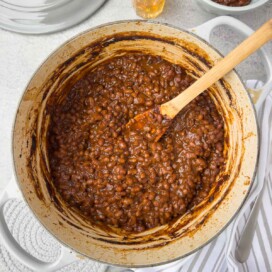
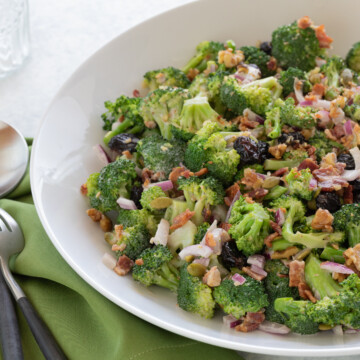
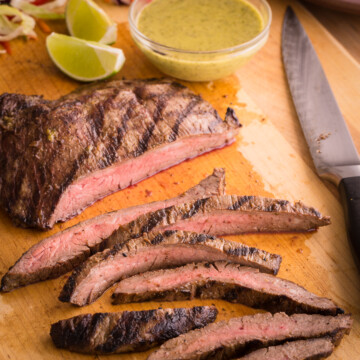
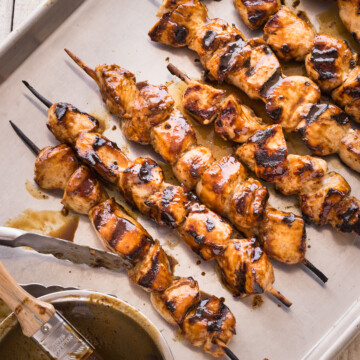
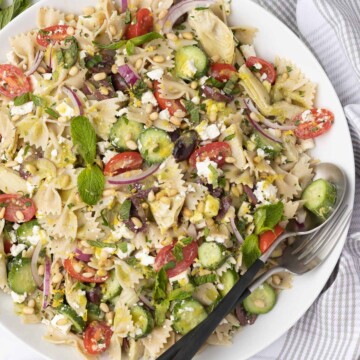
george says
during the baking phase you do not say when to add the mustard or the bay leaf. i would assume this would be when adding the other dry ingredients.
im guessing this was just an editorial oversight. Wife and I made this for Christmas Dinner (going with a bbq theme this year) and so far it looks and smells great
Sally Cameron says
Hi George, thanks for catching that and being another set of "eyes". Just corrected on where to add the mustard and bay leaf. Please let me know how they come out. How fun to do a Christmas bbq! Here's to new traditions. I am doing smoked turkey breasts on my pellet grill for the first time. The beans would have been perfect with it! Merry Christmas.
Mrs Fiona Petrie says
I can only get blackstrap molasses but the recipe clearly says not to use this. My question is why not and what would be the best substitute?
Sally Cameron says
Hi Mrs. Petrie. When I updated the recipe I forgot to make that change. What I use is actually blackstrap molasses. It's easy to get this mixed up and I think other recipes have it mixed up too. I've updated the recipe so as not to confuse people, so thank you for helping me to clarify that. Reading about how molasses is made and the different levels can be confusing. The front of the bottle I use says simply unsulphured molasses. You wouldn't realize it is actually blackstrap unless you read the ingredient label. The two common brands in the stores (in my area) are Grandma's and Wholesome. I use the organic Wholesome brand. Blackstrap is often used in recipes for baked beans, gingerbread, bran muffins, molasses cookies, and BBQ sauce for it's rich, deep, slightly bitter flavor. I hope that helps and thanks again.
Melissa S. says
I came to your website looking for baked beans and I found some!! I have pinto beans, red beans, and navy beans. Would one of these also work? Are the other's more nutritious?
Sally Cameron says
Hi Melissa, I think you could probably use any of them that you like and they would be good! Please report back on which you choose so other readers can benefit. Thanks!
Lori says
Made this today. I have a 3 year old, I will keep you posted.
Sally Cameron says
Please do Lori, I hope your little one likes it.
Francesca says
Glad I caught this entry before the month ended! I had no idea Baked Bean month. I'll definitely try this. Thanks for sharing!
Dr. Patrick Mahaney says
This makes me want to barbecue!
I am going to forward this recipe to my mom and sister as a means of making the beans without white sugar or ketchup (also containing sugar in the form or 2 types of corn syrup...yuck).
PM
susan says
Yay for baked beans month! Yours is a meal, all wrapped up into one little pot! We need to coordinate a baked beans pot luck!
Rivki Locker (Ordinary Blogger) says
This looks great. I've never seen ginger puree. Do you know of any substitutes?
Sally says
Hi Rivki. Every grocery store has it. You can usually find it in the produce department in little jars. I prefer the organic kind. Right now I am using the brand from The Ginger People. The label says minced ginger, but its a fine puree and so easy to use. If you can't find it, use fresh ginger pieces, peeled, the rubbed over a microplane grater for fine juicy ginger.
Ron says
Beautiful!